“I don’t deserve this award, but I have arthritis and I don’t deserve that either “
Jack Benny- Emmy-Winning American Entertainer
Table of Contents
Introduction
October is here, and with it, World Arthritis Day on the 12th. This day is dedicated to recognizing the millions of people living with arthritis, a condition that can be caused by various knee pain causes. Arthritis can impact any joint in the body, including the knees.
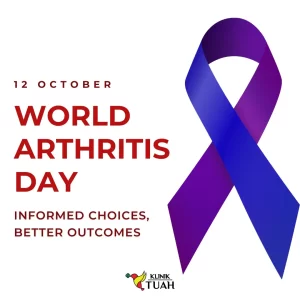
Unfortunately, many people overlook the signs, often thinking their knee pain is caused by other factors. It’s a condition that affects their daily lives, from constant joint pain to struggling with simple activities.
I remember a young, career-driven acquaintance of mine who was always on her feet. She often complained about knee pain, brushing it off as a sports injury. But one day, her knee became swollen, and a hospital visit revealed she had early-stage osteoarthritis.
So, what really causes knee pain? Is it just aging, trauma, or could there be other factors? In this article, we’ll explore some of the most common knee pain causes. Understanding these causes is key to finding the right treatment and preventing future problems.
1. Injury and Trauma
Our knee consists of strong yet sensitive musculoskeletal system that allow us to move freely. However, persistent or critical injury and trauma can cause any of these systems to weaken, thus causing knee pain. Some of the most common injury and trauma includes;
a. Ligament Injuries
Ligament is fibrous of tissues that connect the bones and give stability to knee joint. Our knee has 4 main ligaments which are ACL, MCL, LCL, PCL. One of the main knee pain causes is damage to the knee ligaments. The most common ligament injuries include:
- ACL Tear: The Anterior Cruciate Ligament (ACL) injury often due to sudden sports that involves sudden stops, twisting, jumping or hard landings. Famous athletes like Serena Williams have had ACL injuries, although it’s more common in sports like basketball, soccer, or football. The pain can range from mild discomfort to loss of sensation in the knee.
- MCL and LCL Injuries: The MCL (inside of the knee) usually injured due to direct blow to the outside of the knee. The LCL (outside of the knee) injuries are less common, but typically result from direct impact or trauma to the inside of the knee and affect the stability of the knee. Contact sports like rugby and soccer are some of the main knee pain causes.
- PCL Injuries: Posterior cruciate ligament (PCL) is the ligament that connects upper and lower leg. Although PCL is stronger than ACL,PCL can get injured as well. Usually, the injury to the PCL is caused by fatal car crash and hyperextension injury or extreme twisting during sport.
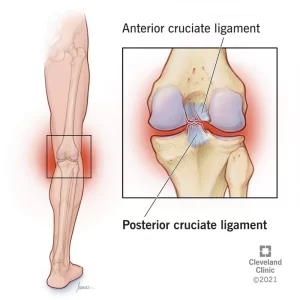
b. Meniscus Tears
The meniscus is made up of two C-shaped pieces of tough cartilage. The meniscus act as cushions and absorb shock when you are bearing weight on your knee. However, the extra pressure can cause the meniscus to tear.
The good news? Some torn cartilage can be treated with ice, medication and enough rest. But for more serious cases, surgery might be the option to fix the tear.
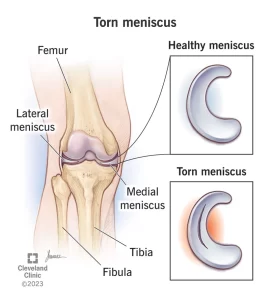
c. Knee Bursitis
Before we dive into bursitis, let’s explain a component inside the knee. Between the joints are fluid-filled sacs called bursae, which reduce friction and allow two body parts (bones and ligaments, joints and skin, or tendons and muscles) to slide easily against each other.
However, too much kneeling can cause inflammation in the bursa. This condition is called knee bursitis, or housemaid’s knee. Housemaids often kneel while wiping the floor or cleaning the toilet bowl, hence the name.
The most common form of knee bursitis is prepatellar bursitis, which is inflammation of the kneecap. Knee bursitis can cause swelling and extreme pain in the knee.
2. Overuse and Repetitive Strain Injuries
Overuse of the knee can strain the joint and become one of the common knee pain causes. Activities like running, cycling, or skiing can put excessive stress on the knees, leading to discomfort and inflammation.
a. Patellofemoral Pain Syndrome
Ever heard of runner’s knee? Runner’s knee, or patellofemoral pain syndrome (PFPS), refers to pain in and around the patella (kneecap) and mostly occurs in athletes who “overuse” the front of their knees.
This condition results from repeated excessive stress on the kneecap caused by bending and straightening the knees. PFP usually happens due to activities like running, biking, or skiing, and it can also occur because of misalignment of the kneecap.
b. Iliotibial Band Syndrome (ITBS)
Iliotibial band Syndrome (ITBS) is pain on the sides of the knee. Iliotibial band (ITB) is a connective tissue that runs the side of the thigh from the hip to your knee. When ITB tightens, it rubs against the bone outside of the knee (lateral side) causing friction and inflammation. It’s common in basketball players, cyclists and skiers, and causes pain on the outside of the knee.
c. Patellar Tendinitis
Patellar tendinitis , often called “jumper’s knee,” is overuse injury that causes pain under the kneecap. This injury commonly seen in athletes who involve in sports with lots of jumping or running. The patellar tendon, which connects your kneecap to your shinbone, can become inflamed and irritated, causing pain and stiffness.
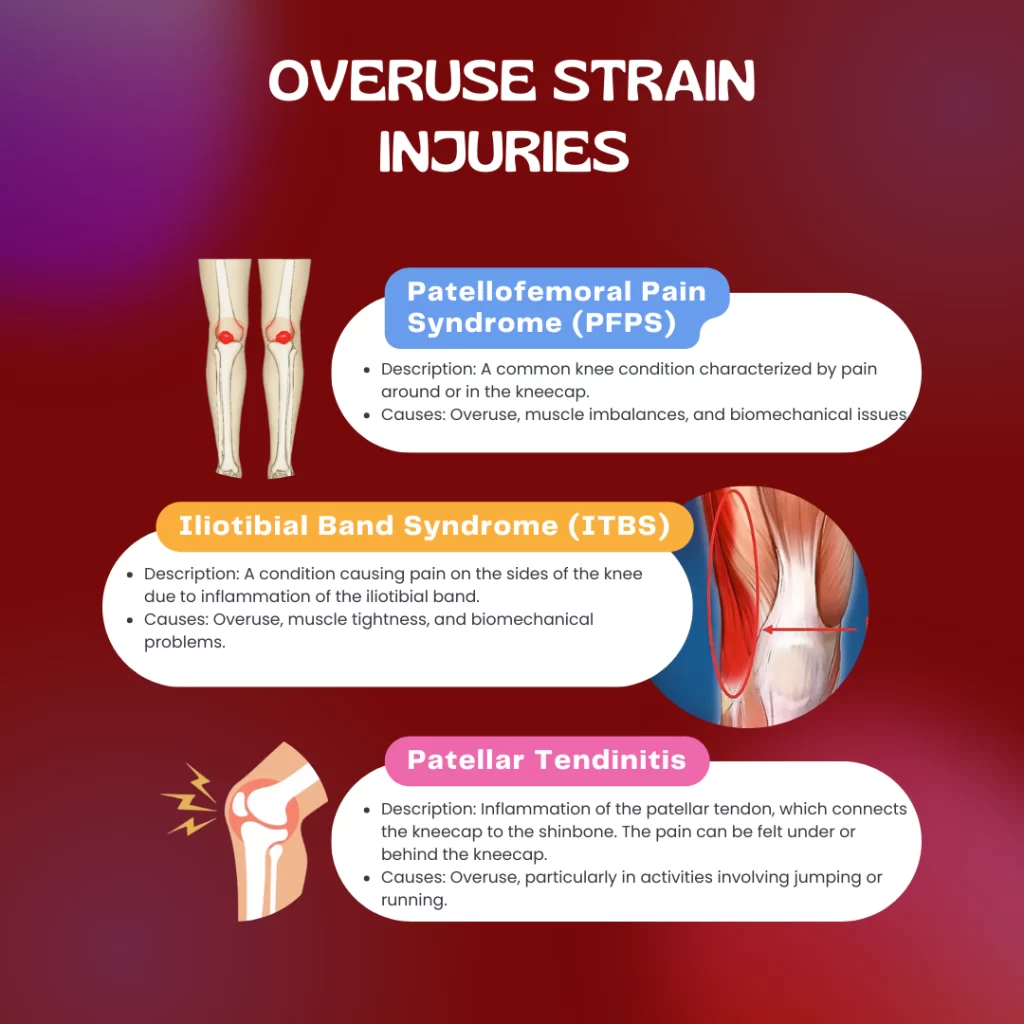
3. Arthritis: The Pain of the Joints
Arthritis is a condition that causes inflammation and stiffness in the joints, leading to pain and reduced mobility. It can affect any joint in the body, including the knees, hips, and hands.
a. Osteoarthritis
Osteoarthritis (OA) is the most common type of arthritis and usually happens to senior citizen. It happened due to the wear and tear of the cartilage that lubricate the joints. Thus, the bones rubbing against each other, which cause the joint to be inflamed, swollen and in immense pain.
Osteoarthritis is very common, that 80% of people with age 55 years and above have osteoarthritis. Osteoarthritis can range from mild pain to immobility.
b. Rheumatoid Arthritis
Rheumatoid arthritis (RA) is an inflammatory condition where the immune system mistakenly attacks the joints, including the knees. Unlike OA, which is caused by wear and tear, RA cause a painful inflammation as it affects the joints lining. Some RA symptoms include pain, swelling, stiffness and fever.
c. Gout
Gout is a type of arthritis caused by a buildup of uric acid crystals around the knee joints, causing the inflammation. The pain often come suddenly, severe and reduce the ability to use the knee.
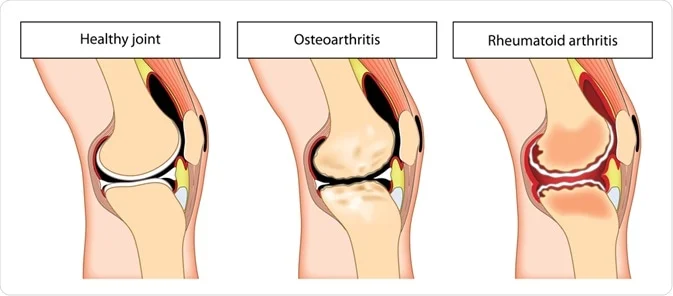
4. Other Possible Knee Pain Causes
Some other possible causes of knee pain include:
a. Dislocated Kneecap (Patellar Dislocation)
b. Loose Body in the Joint
c. Hip or Foot Problems
d. Septic Arthritis
e. Osgood-Schlatter Disease
Tips to Treat Knee Pain
While some knee pain causes, like aging and certain medical conditions, are unavoidable, there are steps you can take to protect your knees from injury and strain:
• Use the R.I.C.E. method (Rest, Ice, Compression, Elevation)
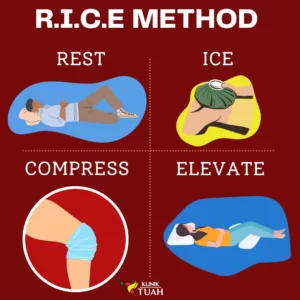
• Take supplements such as Omega-3,Glucosamine and Chondroitin.
• Consider pain relievers such as paracetamol, NSAIDs, or steroid injections
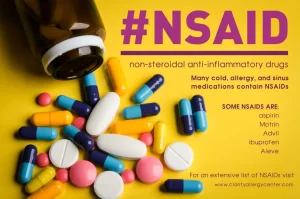
• For longer-lasting relief, you could explore knee pain treatment injections such as HA injection.
Learn more about knee pain treatments here
Read our complete guide on knee pain here
Conclusion
Knee pain can come from various causes, whether it’s due to aging, injury, infection, or other knee pain causes. Living with knee pain is definitely challenging, but understanding the cause and learning how to manage it can greatly improve your quality of life. Be sure to talk to your doctor to pinpoint the exact issue and find the right treatment for your knees.
FAQ
Can knee pain go away on its own?
Knee pain caused by minor injuries, such as muscle strain, overuse, or mild discomfort from activities, can often be relieved with rest, icing, and simple stretching exercises.
Can poor footwear cause knee pain?
Yes, unsupportive, worn-out shoes or high heels can affect knee alignment.
Are women more prone to knee pain?
Yes, due to hormonal changes and anatomical differences.
Can back problems cause knee pain?
Yes, bulging disc or pinched nerve in lower back. It is because the nerve can send pain signals down to your knees. Back problems can also change the way you walk or move, putting extra stress on your knees and causing pain over time.
No ONE DESERVE TO LIVE in pain






